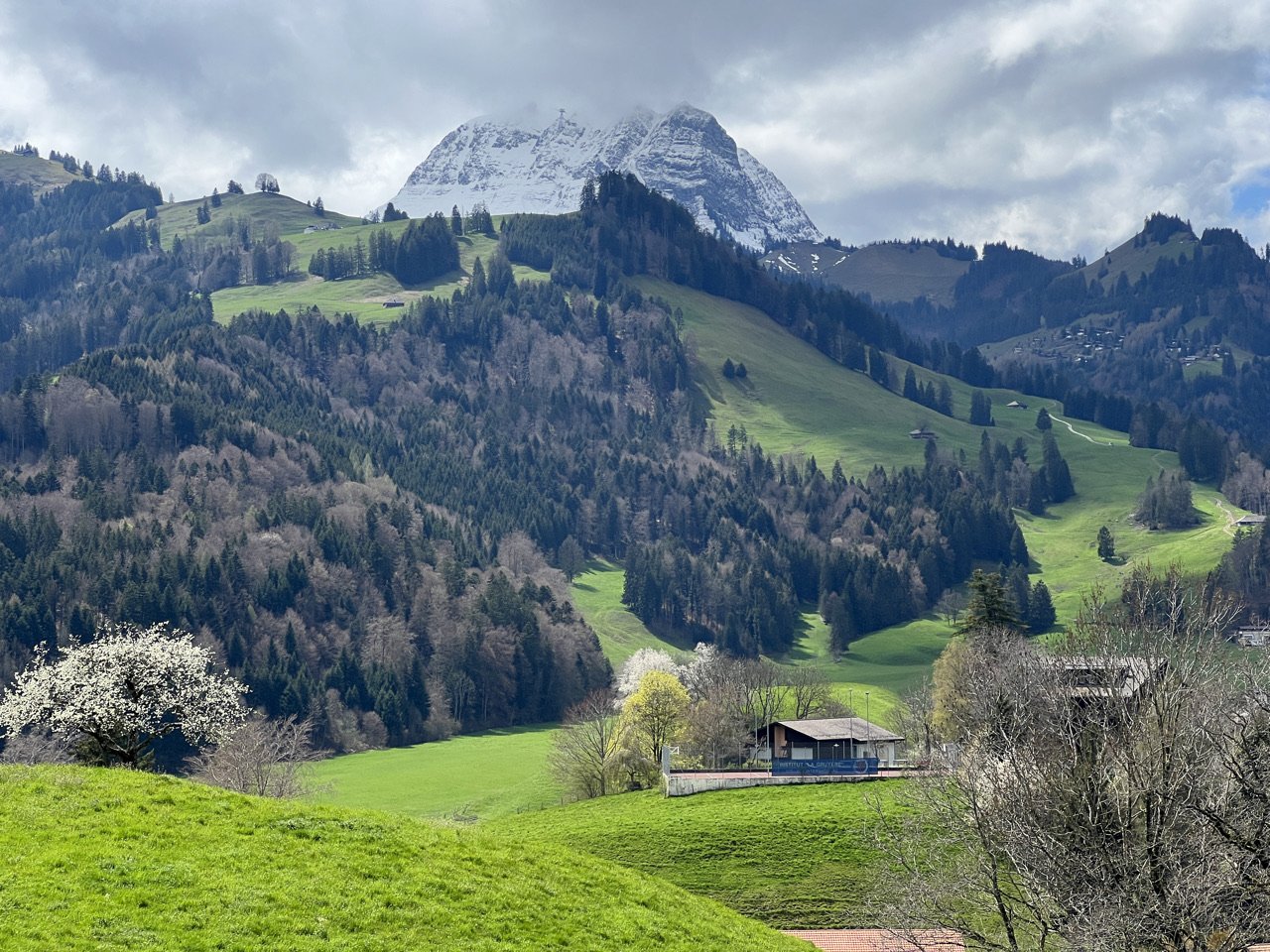Day 575 Gruyere, Switzerland
Gruyere Cheese and Fondue
Christian, our friend from our transatlantic voyage, has picked us up and whisked us north along Lake Geneva. It’s morning and the big lake is frosted gray beneath the Alps, capped in fresh white snow. Beyond, in the thin mist, I can see the mouth of the Rhône river and the great valley it took millions of years to create on its journey to Lake Geneva. As we rise higher a sign along the highway indicates that as we cross through these Alpine foothills all water to the right will fall to the Rhône River marching its way to Marseille and the Mediterranean Sea, while every drop to the left will find its way to the Rhine and Rotterdam Bay.
We are taking this trip because Christian wants to share some of Switzerland's finer gifts, and so after 45 minutes we find ourselves at the Gruyere Cheese Factory and Museum. Cheese is certainly something the Swiss have mastered. This is where all of the world’s Gruyère is made and it comes only from cows that graze in the alpine foothills nearby. It's a cool spring morning, 53º with fluffy cumulus clouds tumbling over the hills.
Christian steps out of the car. "Enjoy the fresh air," he says with a grin, "because it's the only thing that's free in Switzerland."
It IS expensive in Switzerland, though on this particular day we wouldn't know it because Christian, the perfect host, refuses to let us pay for a thing; not dinner at the Café De La Post the evening before, not the Gruyere Museum and Factory, not the Restaurante de Ville where we will have lunch, not the works at the famous Callier Chocolate Factory. he will have none of it. This simply seems to be the way Christian is: generous, humble, never making a point of his kindness, an absolute class act. He simply refuses to let you pay a single Swiss franc.
Gruyère cheese is famously delicious the world over. I’ve consumed my share of it, but never knew it was made in Switzerland, and Switzerland alone. Inside the cheese factory we get a crash course in the making of the stuff. Local milk from cows, eating all sorts of fresh herbs and grasses from cumin to thyme, are one of the sources of the cheese’s distinct flavor. We watched the cheese’s metamorphosis from milk whey to the great wheels that emerge from the factory’s cellars where it is shipped onto sandwiches, crackers, apples, pears, and the fondue pots of billions around the world. We were each given three samples, and each was more firm and smoky and delicious than the one before.
Above the factory, sits the village of Gruyère itself, hung on a high hill, where a castle sits, once the home of the count of Gruyère. The castle is perfectly situated, at least it was 1000 years ago, when it was first built to protect the upper valley of the Soane river.
These days, it's a fine Alpine Village, right out of Disneyland. Yet, strangely, in the midst of all of these medieval buildings, one Catholic chapel has been turned into a Tibetan Museum (also its name) founded by Alain Bordier, the result, according to the brochure I found, "of 40 years of passion for the art of the Himalaya!" It brims with artifacts from the mountains of Tibet that are older than many of the buildings in the medieval town that surrounds it: bronze statues of Bodhistattiva Vajrapani, Buddha Shakyamuni, the lotus eating Avolokiteshvra Padapani and hundreds more, polished, glass encased amidst the medieval masonry which is still painted on the high walls and ceilings with the effigies of Mary and Jesus. Stained glass windows show off more Christian iconography. It's an arresting combination of images, but somehow I found it perfectly reasonable in a country that runs so well even though its inhabitants speak three languages (four if you count English). Strength in diversity.
Christian strongly suggests fondue for lunch and so we enter the Restaurante de Ville right off the town square. After downing the fondue, Christian devilishly insist that we have the berries and cream with fluffy sugared meringue on the side, another Swiss delicacy. Nothing too fattening. This is not like the whip cream that we find in the US. It's double cream from the top of local cow’s milk and it's not sugared, but it is nearly as thick as butter. The meringue provides just the right combination of sweetness. Christian explained we must take a bit of the meringue, spoon it in a dollop of cream and add a berry before popping it all into our mouths. The result is orgasmic.
Chocolate at Cailler Chocolate Factory
As if this dolce isn't enough, our next excursion takes us to the Cailler Chocolate Factory in nearby Brulle. The factory is a great white washed castle that reminded me of Willy Wonka's chocolate factory. We really don't see much of the actual making of the chocolates. Mostly we’re shown through an elaborate and beautiful series of moving dioramas, each one one telling the story of a benchmark in Cailler's history.
Before departure, we do watch a series of small chocolate candies being perfectly wrapped by robots that then roll down an assembly line, available to anyone that has visited the museum. Since that would be us, we naturally snatch a few and stuff them in our pockets for later when we may need sustenance.













